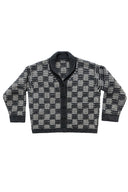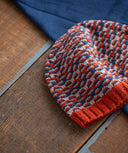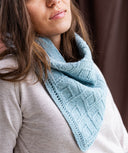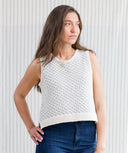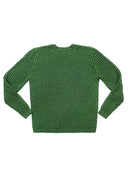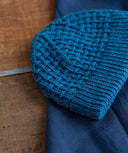Selecting a Sweater Size 201
At Brooklyn Tweed, we believe every single body is knit-worthy exactly as it is and we want you to create a sweater that fits just the way you want. Before diving deeper into the topic of how to select what size to make, it is important to establish a few things. First, this article is intended to provide information and guidelines so that you can create a garment with the perfect fit for you. You determine what that perfect fit is, whether it's a sweater with lots of positive ease, or a little negative ease, or somewhere in between. (Read more about ease in Selecting A Sweater Size 101.) You may prefer various amounts of ease in different styles or sweater shapes. You can use existing garments in your closet and the photos in the pattern to help guide how much ease you want a specific sweater shape to have. Different shapes have different key fit measurements that we will explore in more depth below.
A New Dimension
As discussed in Selecting a Sweater Size 101, accurate measurements of your body and/or your favorite garments are vital. In addition to your full-chest, waist, and hip circumferences, it is also helpful to know your bicep and upper-chest circumferences.

The upper-chest circumference is measured at the underarms, with the measuring tape pulled snugly as depicted in the photo below at left. The photo at right shows the full-chest being measured. You can take your measurements yourself or have a friend or family member help you.

Making The Grade
To begin to understand how to pick the pattern size you want to create, it is important to first understand how all of the sizes were created. At Brooklyn Tweed we start with our standard measurement grading block, based on average body measurements across a range of sizes. We use these measurements to determine the dimensions of the finished garment, so that someone with a 30"/76 cm chest can have a garment that looks and fits with similar ease to someone with a 70"/178 cm chest.
There is one inherent shortfall with this process — it is based on averages, and your body is unique. One of the most common variations to the average measurements is the difference between the full chest and the upper chest. The averages are based on a 2-9"/5-23 cm difference between the two circumferences, while in reality the differences can vary significantly from person to person. Given individual differences in variance between full chest and upper chest measurements, selecting a size based only on the full chest measurement may result in an upper body that does not fit the way you expect for some sweater styles.
But information is power, and by knowing how a pattern size is created in relation to your unique measurements, you are empowered to create the garment with just the right fit for you. To aid in this, we have added two new measurements to our schematics where appropriate: the cross-front or cross-back width and the upper-chest circumference. The cross-front or cross-back width will be the garment width at these points, while the upper-chest circumference will be a reference to the upper-chest body circumference that was used in the grading (i.e. sizing) of the pattern. We will supply these measurements on garments that have a more defined upper-body shape, such as a set-in sleeve pullover or cardigan, where the placement of the vertical line of the armhole is intended to sit close to where your arm meets your body. For garments like circular yoke or raglan sweaters, there is no analogous line in the garment and so these measurements are omitted. See below for examples of when these measurements do, and do not, come into play for particular garment shapes.

Keys To Choosing Your Perfect Fit
So how do you know which measurement you should focus on when selecting a size? The answer depends entirely on the garment shape and style. Before you look at specific measurements to decide your size, review the shape of the garment. Is it a pullover or cardigan? How does the upper body of the garment sit on the model? Does the schematic include the cross-front and/or cross-back measurement(s), or refer to the upper-chest measurement used to create the size? These clues can often tell you what measurement to focus on for a similar fit.
For garments with less defined upper body fit, the full chest circumference is the key fit measurement to pay attention to. To determine if a sweater has a less defined upper body fit, look at where the sleeves meet the upper body of the sweater — is it all one piece as with a circular yoke such as Otte or a few inches down the arm as with a boxy pullover like Bewick?

Boxy sweater shapes also often allow for easy customizations to sleeve sizing, working one size for the body of the sweater and a different size for the sleeves (see Bradhan, Ecola).
 Examples of boxy garments that allow for mix-and-match sizing.
Examples of boxy garments that allow for mix-and-match sizing.
For garments with more defined upper body fit, the upper-chest circumference, or cross-front/cross-back width, is the key fit measurement. Example patterns include Modern Tabard, Saddler, and Byssa, shown below. To determine if a sweater has a more defined upper body fit, look at the armhole shape — does it follow along the line created where your arm meets your upper-chest as with a set-in sleeve or saddle-shoulder pullover?



With set-in sleeve garments, it is more complex to mix and match sleeve and body sizes, so look at both the bicep and upper-chest circumferences to find your preferred size. Depending on your personal upper-chest/full-chest ratio, you may find that selecting a size based on the upper chest results in a sweater with less ease at your full chest. Remember that most knit patterns have a lot of stretch, and can still fit comfortably with zero or negative ease at the full chest.
If a pattern schematic does not list the cross-front/cross-back width but is a shape with a more defined upper body fit, you can calculate the cross-front/cross-back measurement by adding the shoulder widths and neck width measurements together.
Working With Unique Fit Measurements
Finally, there are garments with unique key fit measurements. For example, for an open-front cardigan (see Intersect below), the cross-back measurement is key to getting the upper body to fit correctly, while for a dolman-sleeve pullover (e.g. Chabot), the neck-to-elbow length measurement is key to getting the armhole to sit in exactly the right place. Look for fit notes within the pattern, or think about what you like about the fit of similar garments when selecting a size for these unique styles.

The Takeaway
Hand-knit sweaters are an investment of your time and resources. Taking some time before you cast on to think about how the final garment will fit your body can make the difference between a sweater that fits ok and a sweater that fits exactly right. It is our hope that by understanding the key fit measurements for different garment shapes, you are empowered to make a wide range of sweaters that are perfect for you.
By Boann Petersen — When she is not working her day job, Boann's free time includes tech editing for Brooklyn Tweed, designing knitwear, and solving puzzles. Follow her work on Instagram @boannknits.
Photographer: Jared Flood
Model: Tammy Rosecrans
